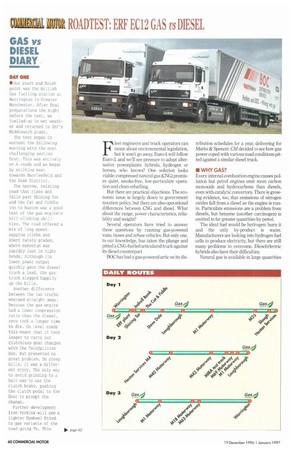F leet engineers and truck operators can moan about environmental legislation,
Page 62

Page 63

If you've noticed an error in this article please click here to report it so we can fix it.
but it won't go away. Euro-4 will follow Euro-3, and we'll see pressure to adopt alternative powerplants: hybrids, hydrogen or horses, who knows? One solution looks viable: compressed natural gas (CNG) promises quiet, smoke-free, low-particulate operation and clean refuelling.
But there are practical objections. The economic issue is largely down to government taxation policy, but there are also operational differences between CNG and diesel. What about the range, power characteristics, reliability and weight?
Several operators have tried to answer these questions by running was-powered vans, buses and refuse vehicles. But only one, to our knowledge, has taken the plunge and pitted a CNG-fuelled articulated truck against its diesel counterpart.
BOC has had a gas-powered artic on its dis
tribution schedules for a year, delivering for Marks & Spencer. CM decided to see how gas power coped with various road conditions pitted against a similar diesel truck.
111APHYGAS?
Every internal-combustion engine causes pollution but petrol engines emit more carbon monoxide and hydrocarbons than diesels, even with catalytic convertors. There is growing evidence, too, that emissions of nitrogen oxides fall from a diesel as the engine is runin. Particulate emissions are a problem from diesels, but benzene (another carcinogen) is emitted in far greater quantities by petrol.
The ideal fuel would be hydrogen: burn it and the only by-product is water. Manufacturers are looking into hydrogen fuel cells to produce electricity, but there are still many problems to overcome. Diesel/electric hybrids also have their difficulties.
Natural gas is available in large quantities around the world and most developed countries have a supply network. Equipped with a three-way catalyst, a gas engine can produce significantly lower levels of the main pollutants than a diesel. In particular, gas offers huge reductions in particulates (soot) and carbon monoxide.
Then there's noise. Modern diesel trucks are quieter than ever, but direct injection is a noisy process. Gas engines use spark rather than compression ignition to start combustion and gas burns more slowly. As a result it's also quieter.
• THE TEST Many manufacturers have gas-powered vehicles in their model ranges. ERF offered our best hope– the company probably supplies more gas trucks in the UK than any other. Vehicles are in service with 130C Distribution, the Lane Group and Slough Borough Council.
Last year BOC Distribution put a natural gas ERF EC12 into service on its M&S contract. following earlier trials with an EC6 17tonne rigid. Both vehicles are powered by Perkins natural gas engines derived from diesel powerplants. Since BOC distribution has a large fleet of ERFs, we could make a comparison with two near-identical trucks.
Luckily for us Sam de Beaux, 130C Distribution's chief transport engineer, was a judge in our Trailer of the Year competition. The gas project was de Beaux's idea and he was keen to set up a test. Ideally, we would have taken two trucks around our Scottish Route but there was one drawback Were there any gas refuelling stations nearby?
The way ahead was to plan the test route around the gas filling stations available. Although the results could not be compared with other Scottish Route tests, they would be directly comparable with the diesel-powered truck that would shadow it around the route.
A meeting was planned with representatives from CM, ERE Varity Perkins—the engine supplier—and British Gas. A route was agreed and the details hammered out. It was the test we'd all been waiting for and it was on.
• THE TRUCKS Both vehicles do distribution work for M&S and are typical shopping trollies. The fouraxle combinations operate on urban delivery routes to M&S stores. Although plated at 32,520kg, they usually gross below 30 tonnes. De Beaux's target power rating is 300hp any more is simply not needed.
Our diesel test vehicle was a little unusual for BOC: it's a sleeper, and its Perkins Eagle Tx engine is rated at 341hp, but it's an exdemonstrator and the price was right.
The gas truck had a day cab, more typical of BOC distribution spec, but like the diesel it had all-steel suspension and an Eaton TwinSplitter gearbox. The only appreciable difference is the wheelbase: BOC normally specifies 3.5m, hut to accommodate six CNG tanks the gas truck has a 3.8m wheelbase. The 300hp engine is the only automotive gasfuelled Tx. Perkins would prefer to run it at 340hp but de Beaux wanted the vehicle to match the rest of the fleet.








































































































































